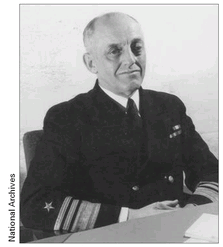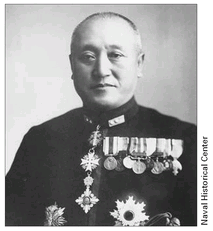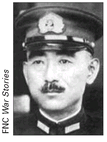War Stories II (34 page)
Authors: Oliver L. North

On Guadalcanal and Tulagi, Vandegrift's troops, already on half rations, cut food consumption by half again. Living in the jungle without shelter or the prospect of medical evacuation for the wounded, and compelled to conserve ammunition in every engagement, they nonetheless managed to finish the runway and parking aprons on Henderson Field. By 11 August they had also succeeded in eliminating most of the Japanese from the jungle surrounding the airfield. The Leathernecks were soon boasting, “We have done so much, with so little, for so long, that we now can do anything, with nothing, forever.”
But for Nimitz and the Marine planners in Hawaii, it was no laughing matter. Though a U.S. submarine had managed to sink one of Mikawa's cruisers, the
Kako
, on 10 August, there was grave concern at Pearl Harbor that a determined counter-attack could spell disaster for the first American offensive of World War II.
Kako
, on 10 August, there was grave concern at Pearl Harbor that a determined counter-attack could spell disaster for the first American offensive of World War II.
On 12 August, in an effort to alleviate the crucial supply problems for the Marines on Guadalcanal, Admiral Turner was ordered to land the division's remaining troops and supplies on Espiritu Santo in the New Hebrides islands. That afternoon, a Marine C-46 transport aircraft flew from the Espiritu Santo airstrip to Henderson Field, delivering urgently needed medical supplies and evacuating a dozen seriously wounded Marines. On the night of 15 August, four little destroyer-transports raced into Ironbottom Sound and offloaded Marine aviation ground crews, ammunition, bombs, and aviation fuel in fifty-five gallon drumsâbut no food.
Unfortunately for the hungry Marines, the Japanese weren't just waiting for them to die of starvation. On the night of 17 August, four Japanese destroyers anchored off Taivu Point and landed 900 Imperial Army soldiers. Their mission: recapture Henderson Field.
The Japanese might well have succeeded but for Vandegrift's remarkable ability to persevere in the face of overwhelming adversity. Wary of Navy promises to protect Guadalcanal with carrier-based aircraft, and despite his gnawing hunger and fatigue, the Marine general bombarded Admiral Robert Ghormley in Noumea and Nimitz in Hawaii with radio messages insisting that they send Marine squadrons to “Cactus”âthe code word for Guadalcanalâto protect his troops. He pulled his defenses tight around the airfield to demonstrate that aircraft would be safe on the ground. His persistence was rewarded on 20 August when nineteen Grumman Wildcat F4F fighters and twelve Douglas Dauntless SBD dive-bombers landed at Henderson Field, flown in from the deck of an escort carrier dispatched from Espiritu Santo.
Â
Admiral Robert Ghormley, in charge of the Guadalcanal invasion, was replaced with Admiral “Bull” Halsey by Nimitz.

The planes arrived just in time. That night, just before dawn, the 900 Japanese troops launched a banzai attack across the Tenaru River in hopes
of overrunning the airfield. The battle lasted for more than eight hours and was, for the Japanese, an unmitigated disaster. More than 800 of the attackers were killed in the assault and subsequent counter-attackâat a cost of 44 killed and 71 wounded from the Marines. Vandegrift's line had heldâand “Cactus” finally had its own air force. In the days ahead, both would be sorely tested.
of overrunning the airfield. The battle lasted for more than eight hours and was, for the Japanese, an unmitigated disaster. More than 800 of the attackers were killed in the assault and subsequent counter-attackâat a cost of 44 killed and 71 wounded from the Marines. Vandegrift's line had heldâand “Cactus” finally had its own air force. In the days ahead, both would be sorely tested.
 BATTLE FOR THE EASTERN SOLOMONS
BATTLE FOR THE EASTERN SOLOMONSNORTH OF MALAITA AND GUADALCANAL
25 AUGUST 1942
1030 HOURS LOCAL
25 AUGUST 1942
1030 HOURS LOCAL
The horrific losses on the banks of the Tenaru persuaded Admiral Yamamoto that Guadalcanal could be retaken if Japanese reinforcements delivered to the island were sufficiently supported by adequate naval forces. To that end, he ordered Rear Admiral Raizo Tanaka to take his flagship, the light cruiser
Jintsu
, three slow transports escorted by four patrol boats, and land 1,300 Imperial Army troops and marines on Guadalcanal. To support Tanaka, Yamamoto dispatched the entire Combined Fleet, under Vice Admiral Nobutake Kondo, from Truk to destroy the aircraft on Henderson Field, attack any U.S. ships in the area, and support the landing.
Jintsu
, three slow transports escorted by four patrol boats, and land 1,300 Imperial Army troops and marines on Guadalcanal. To support Tanaka, Yamamoto dispatched the entire Combined Fleet, under Vice Admiral Nobutake Kondo, from Truk to destroy the aircraft on Henderson Field, attack any U.S. ships in the area, and support the landing.
Â
Vice Admiral Nobutake Kondo commanded the Japanese Second Fleet at Guadalcanal.

Kondo's fleet included two heavy carriers,
Shokaku
ânow repaired from damage suffered on 8 May in the Coral Seaâand
Zuikaku.
He also had a light carrier,
Ryujo
, which he sent in advance to destroy the Marine and Army Air Corps aircraft on Henderson Field.
Shokaku
ânow repaired from damage suffered on 8 May in the Coral Seaâand
Zuikaku.
He also had a light carrier,
Ryujo
, which he sent in advance to destroy the Marine and Army Air Corps aircraft on Henderson Field.
Early on the afternoon of 24 August, a long-range patrol plane out of Henderson Field spotted the
Ryujo
about 100 miles due north of Malaita
Island. When he received the report, Admiral Fletcher was holding station 150 miles east of Guadalcanal with
Enterprise
and
Saratoga
. Though he had sent the
Wasp
carrier group south to refuel earlier in the day, Fletcher nonetheless ordered an immediate attack on the Japanese carrier by thirty dive-bombers and eight torpedo planes.
Ryujo
about 100 miles due north of Malaita
Island. When he received the report, Admiral Fletcher was holding station 150 miles east of Guadalcanal with
Enterprise
and
Saratoga
. Though he had sent the
Wasp
carrier group south to refuel earlier in the day, Fletcher nonetheless ordered an immediate attack on the Japanese carrier by thirty dive-bombers and eight torpedo planes.
Ryujo
was practically defenseless, having launched all her aircraft for the attack on Henderson Field. A well-coordinated bomb and torpedo attack sent her to the bottom in less than an hour. Her bombing raid on Henderson fared little better. Marine fighters, vectored by radar to intercept the attackers, downed several. Those who survived turned around but found only an oil slick where their carrier had been.
was practically defenseless, having launched all her aircraft for the attack on Henderson Field. A well-coordinated bomb and torpedo attack sent her to the bottom in less than an hour. Her bombing raid on Henderson fared little better. Marine fighters, vectored by radar to intercept the attackers, downed several. Those who survived turned around but found only an oil slick where their carrier had been.
While the “Cactus Air Force” was beating off the Henderson Field raid, Wildcats from
Enterprise
and
Saratoga
were doing the same. In the gathering dusk, Kondo's dive-bombers and torpedo planes from
Shokaku
and
Zuikaku
didn't spot
Saratoga
, so they came in three fast waves against
Enterprise
. American fighters high overhead decimated the attackers, who then flew into a hail of anti-aircraft fire. The battle lasted fewer than ten minutes. When it was over,
Saratoga
had taken three bombs on her flight deck that damage control parties promptly dealt withâallowing her to recover her air wing and continue under way at twenty-four knots.
Enterprise
and
Saratoga
were doing the same. In the gathering dusk, Kondo's dive-bombers and torpedo planes from
Shokaku
and
Zuikaku
didn't spot
Saratoga
, so they came in three fast waves against
Enterprise
. American fighters high overhead decimated the attackers, who then flew into a hail of anti-aircraft fire. The battle lasted fewer than ten minutes. When it was over,
Saratoga
had taken three bombs on her flight deck that damage control parties promptly dealt withâallowing her to recover her air wing and continue under way at twenty-four knots.
Â
Admiral Raizo Tanaka was a brilliant naval strategist who escaped many Allied traps in the seas off Guadalcanal.

Fletcher's dive-bombers and torpedo planes, unable to find Kondo's two remaining carriers in the dark, attacked and sank the
Chitose
, a large seaplane tender, on their way back to the U.S. carriers. By midnight, Kondo, having lost a light carrier and more than ninety planes and pilots, turned around and headed back to Truk.
Chitose
, a large seaplane tender, on their way back to the U.S. carriers. By midnight, Kondo, having lost a light carrier and more than ninety planes and pilots, turned around and headed back to Truk.
But the battle wasn't over. Early on the morning of 25 August, the dawn patrol out of Henderson Field found Tanaka's little group of transports preparing to disembark troops and supplies on Guadalcanal. The Marines scrambled their dive-bombers, and after a five-minute flight from Henderson Field, sank a troop transport and blasted the
Jintsu
âvery nearly killing Tanaka. An hour later, Army Air Corps B-17s from Espiritu Santo arrived overhead and sank a destroyer.
Jintsu
âvery nearly killing Tanaka. An hour later, Army Air Corps B-17s from Espiritu Santo arrived overhead and sank a destroyer.
This was enough for even the indomitable Tanaka. Taking advantage of a tropical downpour, he turned the remnants of his battered force back to the north and headed up the slot, staying beneath the clouds to avoid pursuit.

Unfortunately for Tanaka, he didn't go far enough. Late on 27 August, Tanaka held up in an anchorage in the Shortland Islands, off the south coast of Bougainville. Assuming that he was beyond the range of any U.S. aircraft, he started repairs on
Jintsu
, the two surviving transports, and a destroyer, all of which had been damaged two days earlier. An Australian coast watcher reported the Japanese presence to Admiral Ghormley in Noumea, who in turn relayed the information to the Marines. At dusk on 28 August, a flight of six SBD dive-bombers from Henderson Field, having carefully conserved fuel on the 275-mile-long flight, appeared overhead and proceeded to sink one armed transport and damage two others. By the time the Marine aircraft landed back on Guadalcanal they claimed they were “flying on fumes.”
Jintsu
, the two surviving transports, and a destroyer, all of which had been damaged two days earlier. An Australian coast watcher reported the Japanese presence to Admiral Ghormley in Noumea, who in turn relayed the information to the Marines. At dusk on 28 August, a flight of six SBD dive-bombers from Henderson Field, having carefully conserved fuel on the 275-mile-long flight, appeared overhead and proceeded to sink one armed transport and damage two others. By the time the Marine aircraft landed back on Guadalcanal they claimed they were “flying on fumes.”
The “Battle of the Eastern Solomons,” as the engagement of 24â25 August came to be known, finally convinced Yamamoto that daylight reinforcement and resupply for the Japanese troops on Guadalcanal was too costly. From then on, it became Combined Fleet policy to have fast destroyer-transports, sometimes escorted by cruisers, loiter in the slot until dark and then dash south to disgorge their troops and cargo off the north or west coast of the island. After offloading their payload, the Japanese would swing around Cape Esperance into Ironbottom Sound, fire several salvos at Henderson Field, and race back up the slot before first light.
By early September the pattern became so regular that the Marines took to calling the nightly deliveries and attacks the Tokyo Express. Despite pleas from Vandegrift for night-fighters to interdict these nocturnal forays, there was little that Ghormley or Nimitz could do to help. On 31 August, a Japanese submarine sent a torpedo into the
Saratoga
's sideâsending her into the repair yards for three months. Nobody in Hawaii wanted to risk the
Hornet
and the
Wasp
âthe only two undamaged carriers left in the Pacificâon a
night engagement with the Japanese. The Marines would just have to dig their holes a little deeper and pray that some supplies could get through.
Saratoga
's sideâsending her into the repair yards for three months. Nobody in Hawaii wanted to risk the
Hornet
and the
Wasp
âthe only two undamaged carriers left in the Pacificâon a
night engagement with the Japanese. The Marines would just have to dig their holes a little deeper and pray that some supplies could get through.
Other books
Iris Avenue by Pamela Grandstaff
Curves and Mistletoe by Veronica Hardy
Phantasos by Robert Barnard
Take Mum Out by Fiona Gibson
Enough by Pacheco, Briana
The Survivor Chronicles: The Risen by Erica Stevens
Fire and Fury by Michael Wolff
The Red Rose Box by Woods, Brenda
A Fortune to Die For (White Oak - Mafia Series Book 1) by O'Connor, Liza
Etched in Bone by Adrian Phoenix
